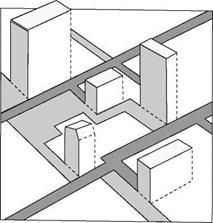With the introduction of CPULs, habitat for animals and birds will increase and therefore so will biodiversity, an example of Ecological Intensification. At the same time, the development of composting systems in support of organic urban agriculture will improve soil condition. Sight and sounds within the city will change. Composting will reduce the number of refuse trucks and improved biodiversity will reintroduce the dawn chorus (see Figure 25.11) with the sound of birds, and insects.
In the earlier paragraph describing exposure to nature, we see how a number of natural phenomena and practical requirements overlay a site;each condition animating the place in a different way, each providing inhabitants with a different meaning for
|
|
|
|
Figure 25.11 Newark CPUL: An individual house designed to minimise non-renewable energy consumption. Its external envelope is super-insulated and natural energy systems are harnessed for domestic energy requirements.
The roof collects solar energy and rainwater while also providing private external living space.
Figure 25.12 Newark CPUL: In this low energy apartment building, the roof collects solar energy for domestic hot water heating and for electricity generation. Rainwater is collected for domestic use. Building and landscape are responsive to the environment.
|
|
|



The degree of compaction in a city will influence the appropriateness of locating productive landscapes centrally or peripherally
Productive urban landscapes have the potential to create new networks of horizontal and vertical green spaces within cities
Figure 25.13
and experience of the place. This is like environmental choreography, marking and mapping experience in space and time. Water (rain) is collected, sunshine penetrates, occupies and conditions space, generates electricity and heats water (see Figures 25.11 and 25.12).
Agricultural fields create changing patterns or paintings in the landscape; this connection and celebration of the real generates delight in the environment.
REFERENCES:
Crouch, D. and Ward, C. (1988). The Allotment, Faber and Faber, London.
Viljoen, A. (1997). The environmental impact of Energy Efficient Dwellings taking into account embodied energy and energy in use. In European Directory of Sustainable and Energy Efficient Building 1997. James and James (Science Publishers).
Viljoen, A. and Bohn, K. (2000). Urban Intensification and the Integration of Productive Landscape. July 2000. Proceedings of the World Renewable Energy Congress VI, Part 1, pp. 483-488, Pergamon.
Figure 25.13 Compaction, de-compaction and strategies for introducing CPULs.





